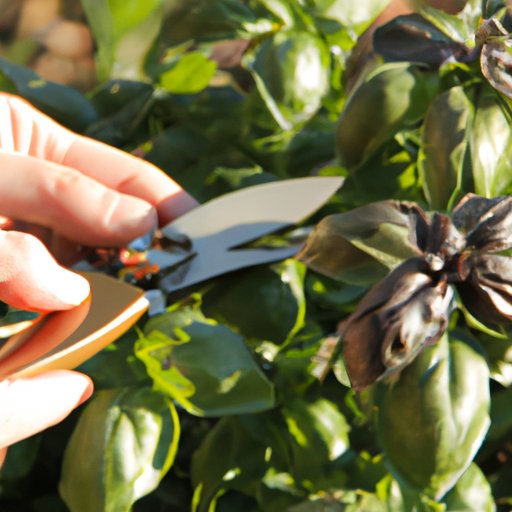
Introduction
If you enjoy growing basil for its potent aroma and taste, then you know that proper care is key to producing healthy basil plants. While it may seem counterintuitive, pruning your basil regularly will encourage it to grow fuller, bushier, and tastier. In this article, we’ll guide you through the process of pruning basil and provide you with tips and tricks to help you get the most out of your plants throughout the year.
Step-by-Step Guide
Before we dive into the process of pruning basil, it’s important to ensure that you have the right tools. Sharp, clean scissors or pruning shears are your best bet when it comes to pruning basil. Here are the steps you should follow:
1. Timing: The best time to prune basil is in the morning, when the leaves are cool and dry. Avoid pruning in the evening or late afternoon, as this will leave the plant open to potential damage from pests and diseases.
2. Amount: As a general rule of thumb, you should aim to remove about a third of the plant’s total height at each pruning to ensure a balanced growth. Always be sure to remove any dead or yellowing leaves.
3. Technique: Make sure to cut the stem right above a pair of healthy leaves, just above the point where it branches off from the main stem. This will encourage the plant to grow two new side shoots off of the remaining stem, creating a fuller, bushier plant.
Visual aids, diagrams, or video tutorials can be extremely helpful in explaining pruning techniques, so be sure to supplement your reading with visuals if needed.
Tips and Tricks
Using sharp scissors or pruning shears instead of your fingers can help you achieve a cleaner cut and reduce the risk of damaging the plant. Practicing proper pruning techniques can also encourage your basil to grow bushier and produce more leaves. Here are a few other tips and tricks to keep in mind:
1. Instead of pruning straight across the stem, try to cut at a slight angle. This will allow water to run off the plant more easily and reduce the risk of water damage or mold.
2. When pruning, make sure to leave at least two sets of leaves on the plant to ensure that it can continue to photosynthesize and produce energy.
3. If you notice your basil becoming too “leggy” or tall, pinch off the tops of the stems to encourage the plant to focus on producing fuller, bushier growth lower down.
Seasonal Pruning
Basil plants require different pruning methods depending on the time of year. From trimming back in the spring to preparing for winter, here are some tips to keep your basil healthy year-round.
– Spring pruning: In the spring, prune basil plants down to the first set of leaves when they are about six inches tall. This will encourage healthy bushy growth throughout the year.
– Late summer pruning: In mid to late summer when the plant has matured, prune back any flowers or flower buds which will turn into seeds. This will ensure a longer growing season for your basil plants.
– Fall/Winter pruning: After the first frost, remove all of the leaves from the stem of the plant. Prune the stem down so that it is only a few inches tall and cover it with soil or mulch. This will help to insulate the roots and promote new growth when the weather warms up again.
Troubleshooting Guide
Pruning can help prevent or fix a number of common issues that basil growers face in their garden. Here are some common issues and how to fix them:
– Yellowing leaves: If your basil’s leaves are turning yellow, it could be a sign of too much water or root rot. Prune off the affected leaves and cut back on watering to prevent further damage.
– Overgrowth: If your basil plants are becoming too large and unmanageable, prune back to a manageable size.
– Pests and diseases: If you notice pests or diseases on your basil, remove all of the affected leaves immediately and dispose of them. This will prevent the issue from spreading.
Recipe Suggestions
Pruned basil can add delicious flavor to many dishes. Here are some recipe ideas to try:
– Caprese salad: Cut up fresh tomatoes and mozzarella cheese, add in fresh basil leaves, and drizzle with olive oil and balsamic vinegar.
– Pesto sauce: Mix fresh basil leaves, pine nuts, garlic, and olive oil in a food processor until creamy. Use as a sauce for pasta or as a spread for bread.
– Margherita pizza: Top pizza with fresh sliced tomatoes, mozzarella cheese, and fresh basil leaves.
Conclusion
Pruning basil regularly is an important part of ensuring healthy, flavorful plants. By following the steps and tips outlined in this article, you can ensure that your basil plants thrive year-round. Remember to be patient, practice proper pruning techniques, and have fun experimenting with recipes in your kitchen. We hope this guide has been helpful to you and encourage you to leave any additional questions or tips in the comments below.





